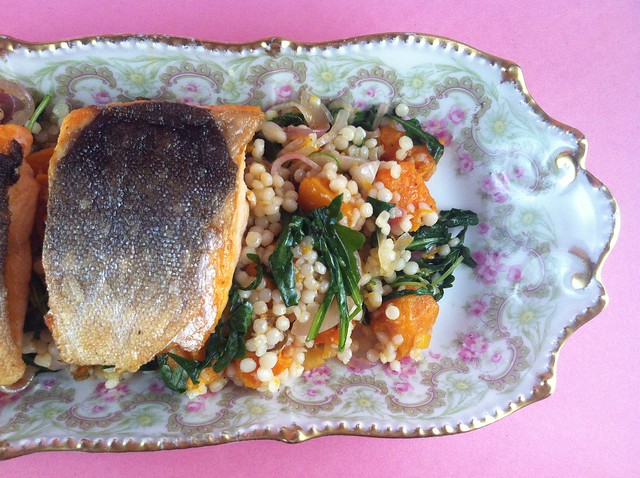Arctic char looks and tastes similar to salmon but I prefer its natural sweetness that lends itself to frying. Cooking either fish filleted is easy as long as you dry them with paper towels and heat your skillet with oil until it’s sizzling–this will keep the fish from sticking to the pan and falling apart when you have to turn them over. Israeli couscous, or ptitim, are shaped like little balls made out of wheat flour rather than the finer North African version made out of semolina. I just added butternut squash here to make the dish more filling. The preserved lemon isn’t necessary here, but I think it makes a nice surprising bite if you have them handy (and, boy, do I have them handy).
This is probably not the dish you’d think of cooking and packing for lunch when you go on a hike, but it’s what I did one Friday night for lunch the next day when I hiked Breakneck Ridge in Cold Spring, New York. We’ve had a dry spell here in the city and I just wanted to be away from concrete for a few hours and be surrounded by some trees and the Hudson River. My hiking companion seemed game for the outdoors even though we just started hanging out, so we met in the train to Poughkeepsie on Saturday morning; him getting on Grand Central, me in Harlem. He earned pogi points for being a good sport and making it to the top of the trail with me, and I think I earned mine for not packing granola bars for lunch.
Wouldn’t you want something extra special to eat with this summer view as well?
Ingredients:
1 small butternut squash, peeled, seeded, cubed
olive oil
salt
1 large onion, peeled and minced
1 preserved lemon, seeded, sliced
a handful of arugula, thoroughly washed, torn
1 3/4 cup Israeli couscous
1 small cinnamon stick
2 fillets of arctic char, rinsed, dried with paper towels
a handful of golden raisins
a handful of parsley, roughly chopped
a handful of pine nuts, toasted1. Preheat the oven to 475º. Toss the butternut squash pieces in a jigger of olive oil and a pinch of salt in a large baking dish. Place in the oven until squash is tender, about 15 minutes.
2. While the squash is cooking, heat some olive oil in a skillet and cook the onions over medium-high heat with a bit of salt until translucent. Combine the squash and onions into a large bowl with the preserved lemon. Toss in the greens to wilt.
3. Cook the Israeli couscous. Bring a large pot of salted water to a boil and cook with the cinnamon stick until tender, about 10 minutes. Drain, but do not rinse, and get rid of the cinnamon. Gently fluff with a fork so that they do not form into one big blob.
4. Cook the fish. Season the fillets with salt and pepper. Heat some more olive oil in a skillet over medium-high heat. When the oil sizzles, add the fish in a single layer with the skin side down. Cook them for 3 minutes, and then using a flat spatula, turn the fillets and cook for another 2 minutes.
5. Add the cooked couscous to the bowl of squash, onions, and lemon and toss with raisins, parsley, and toasted pine nuts. Top with the fish to serve.





